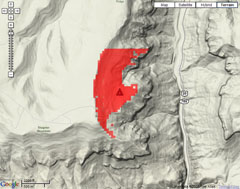Radio Propagation Using libprop
As part of my thesis work, I’ve been writing algorithms to design wireless radio networks. One important question we needed to answer was whether a given pair of locations could communicate using a set of radio equipment. This question is pretty hard to answer because there is so much uncertainty in the real-world. If we make some simplifying assumptions, we can boil the problem down to a handful of calculations.

First we need to check if the link is line-of-sight. That is, can both the towers physically see each other, or is there a mountain in the way? We’re using high-resolution 10-meter data from USGS to walk along a path between the towers, checking for obstructions as we go. If nothing blocks the path, the link might be possible.
Next we need to check our link budget. If the radio isn’t powerful enough, it will be too weak when we reach the other tower. This boils down to a neat equation:
transmitter power (dBm) + antenna (dB) – free space (db) – Fresnel loss (db) – vegetation loss (db)
From our equipment, we know the transmitter power and antenna specifications. From the distance and terrain we can calculate free space, Fresnel, and vegetation losses. Then we compare this budget against the receiver sensitivity of the destination tower. If there is enough signal power left, the link is possible.
This is just a quick summary of what I’ve spent months writing and testing. As part of my fellowship here, I’m allowed to open-source the code I’ve written for my thesis. So if you’re interested in a fast C++ library that can do propagation testing, libprop is the way to go. It can easily read USGS terrain data, and there are some quick examples.
I’ve also written an awesome little mashup that overlays propagation images in Google Maps. It’s an instant “What if we put a tower here?” tool. Other propagation tools on the market are a few thousand bucks, and they don’t even offer anything like this. Check it out and let me know what you think.